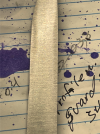- Joined
- Jun 3, 2019
- Messages
- 2,714
I usually have no problems with digging into the edge while grinding .... but recently I have been working on some new thinner stock (~0.07" 26C3), and the last few blades I have had some issues with starting to dig into the edge. I've been able to more or less deal with it .... but on the blade I was working on this afternoon (one of my 6" tomato knife variations) I had a LOT of problems with it. It started digging in about the middle of the edge .... so I just kind of sighed and completed the grind (FFG) and then went to re-profile the edge to remove the concavity. This of course then leaves a slightly thicker edge thickness, especially towards the tip of the knife .... so I started working (carefully) to re-grind the bevel towards the edge to bring down the edge thickness there. Sure enough, as I was doing this that same area that had the edge chewed showed loss of edge again I swear, I was looking and never saw the belt touch that area of the edge (just the flat of the bevel behind it).
Rinse and repeat.
Instead of completely destroying the blade, I basically gave up and salvaged the blade with a non-flat grind but reasonably intact edge .... this knife is for my own use, so I can deal with it. (picture below)

The edge is to the right in this photo. You can see the bevel towards the tip of the knife (top of photo) with three separate bevels. Like I said, every time I tried to reduce that to a single bevel that edge towards the bottom right of the photo would get chewed.
For people who have played a lot with thinner stock (like this 0.07" stock) .... do you tend to run in to this issue more often than with thicker stock???? Most of the other blades I have made have 0.09", 0.1" or 0.12" stock ... and with those I have never had this problem. Two explanations I can think of: 1) I am loosing my coordination (even though as I go I continue to feel like I have more control of the grind and the contact area between belt and blade), or 2) with this thinner stock the angle of the bevel is that much more steep, and unevenness in the grit of the belt will bring just enough "stand out" pieces of grit into contact with the edge, even though my main contact between belt and bevel is below the edge.
I have not done the specific math - but from the trig I do know that as the stock gets thinner, if a FFG is maintained, the angle of the grind goes down *fast*. Makes me wonder whether with this thinner stock al;ways doing a FFG is maybe something to be avoided???
Rinse and repeat.
Instead of completely destroying the blade, I basically gave up and salvaged the blade with a non-flat grind but reasonably intact edge .... this knife is for my own use, so I can deal with it. (picture below)

The edge is to the right in this photo. You can see the bevel towards the tip of the knife (top of photo) with three separate bevels. Like I said, every time I tried to reduce that to a single bevel that edge towards the bottom right of the photo would get chewed.
For people who have played a lot with thinner stock (like this 0.07" stock) .... do you tend to run in to this issue more often than with thicker stock???? Most of the other blades I have made have 0.09", 0.1" or 0.12" stock ... and with those I have never had this problem. Two explanations I can think of: 1) I am loosing my coordination (even though as I go I continue to feel like I have more control of the grind and the contact area between belt and blade), or 2) with this thinner stock the angle of the bevel is that much more steep, and unevenness in the grit of the belt will bring just enough "stand out" pieces of grit into contact with the edge, even though my main contact between belt and bevel is below the edge.
I have not done the specific math - but from the trig I do know that as the stock gets thinner, if a FFG is maintained, the angle of the grind goes down *fast*. Makes me wonder whether with this thinner stock al;ways doing a FFG is maybe something to be avoided???
